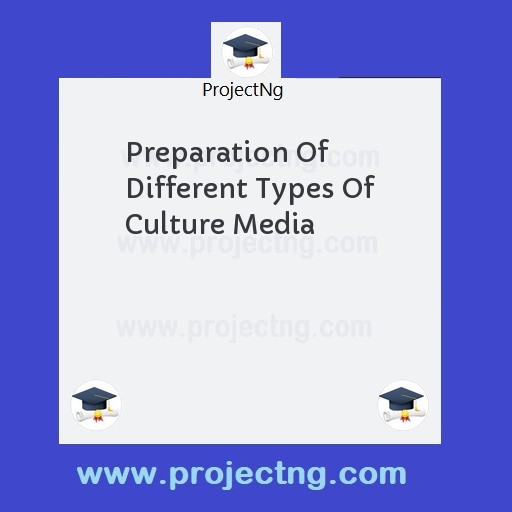Preparation Of Different Types Of Culture Media
Science Lab Technology Project Topics
Get the Complete Project Materials Now! »
PREPARATION OF DIFFERENT TYPES OF CULTURE MEDIA
ABSTRACT
This project is intended to teach and give a general background in culture preparation. It is aimed at giving microbiologist and students specializing in microbiology and related courses the bases on their field of work and study. The preparation of different types of culture media as stipulated in this project, are to guide microbiologist and students in their daily experiences in culturing.
Microorganism as well as acquainting themselves with the techniques and applications involved. These techniques will not only develop the success of the individual, but also guide them to knowing when organisms are present, the type of organism present, then following media mentioned are easy, leap and affordable to prepare for better growth and examination of microorganism. The following are Mac Conkey Agar, which is best to support Gram negative and inhibit Grams positive bacteria.
Another is chocolate (heated blood) agar, it supports the growth of H. influenza, it is also used to culture nutritionally demanding pathogens such as; N. meningitides and finally, blood agar which is gotten from sheep, goat, Horse etc, this contains inhibitions to H. influenza.
TABLE OF CONTENTS
Title Page
Certification
Dedication
Acknowledgement
Abstract
Table of Contents
CHAPTER ONE
1.0 Introduction
1.1 Background information
1.2 Statement of problem
1.3 Aim and objective of the study
1.4 Significance of the study
1.5 Limitation of the study
CHAPTER TWO
2.0 Literature review
CHAPTER THREE
3.0 Materials and methods
3.1 Materials
3.2 Methods
CHAPTER FOUR
4.0 Results and discussion
CHAPTER FIVE
5.0 Conclusion and recommendation
REFERENCE
APPENDIX
CHAPTER ONE
INTRODUCTION
1.1 BACKGROUND INFORMATION
Culture media according to Cheesbrough (2004) are food materials, or nutrients required by microorganisms to support their growth. Enriched media: this contains the nutrients required to support the growth of a wide variety of organisms including some of the more fastidious organisms (those that have and elaborate requirement for nutrients). They are used commonly for cultivating as many different types of microbes as are present in the specimen, examples are blood agar, and nutrient agar etc, in blood agar whole blood is added to nutrient agar to supplement the basic nutrient (Stainer, 1937). Another example is chocolate agar, which is enriched with heat-treated blood, which turns brown and gives the medium the colour for which it is named. Serum, yeast external and vitamin supplement are also used as enriched media (Baker, 1985).
DIFFERENTIAL MEDIA
These contain indicators that distinguish between organisms on the basis of their appearance on the medium.
These media allows certain organisms to produce distinct colonies or characteristic zones around colonies, which are used in distinguishing these organisms from others. For instance, blood agar is both and enriched medium as well as a differential medium between haemalytic and non-haemalytic bacteria.
Another is Maccookey agar, which contain lactose and neutral red dye and distinguish lactose-fermenting organism from non-lactose fermenting organisms. EMB agar is another differential medium used for distinguishing lactose-fermenting organism from non-lactose fermenting organism (Tasie and Okafor 1999).
SELECTIVE MEDIA
These favour the growth of a particular organism, while specifically inhibiting the growth of other organisms, this is used when a particular pathogen is suspected, in which the specimen is inoculated unto a selective medium that prevents the normal microbial floral present not to grow e.g. Endo agar, Mac conkey agar and Eosin methylene blue (EMB) agar. Which all contain dyes that suppress gram-positive bacteria, but allows gram-negative bacteria to grow. A lot of materials such as salt at high concentration can be added into various media, to make them become selective media (Wheetis and Painter, 1987).
Basic media: These are simple media such as nutrient agar and nutrient broth that will support the growth of microorganisms that do not have special nutritional requirement of enriched media. To sub-culturing pathogens from differential or selective media prior to performing biochemical and serological identification test (Cheesbrough 2000).
TRANSPORT MEDIA
These are mostly semi-solid media that contain ingredients to prevent the over growth of commensals and ensure the survival of aerobic and
Be the First to Share On Social

Enjoying our content?
Don't miss out on new videos! Subscribe to our YouTube channel for more awesome content.
Subscribe Now!













